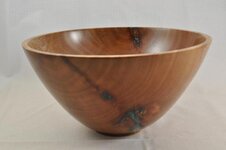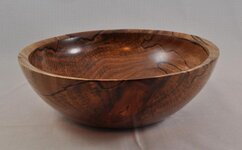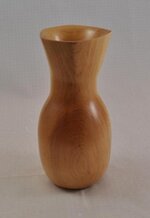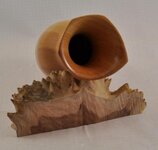I like it all, with the creamer being my favorite. Our local club had a demonstration Tuesday on offset (multi-axis) turning by Barbara Dill. Interesting stuff!
Do tell more about the alumilite infill. Was it done in a single pour? Any tricks to the process?
One last question, for this post anyway.... How do you preserve the Waterlox. That stuff is expensive and has a very short shelf life unless you take extra precautions. I bought some recently but haven't opened it yet.
-Tony
Thanks, I am having a lot of fun with this multi axis stuff
Here is the process and underlying assumptions I used for the Alumilite infill
It takes multiple pours unless you are really lucky on void placement. In this case, the voids did always not go all the way through the piece and were at multiple locations around it. In theory, you might be able to build up some dams with playdough all over the place, but that might be more trouble than doing multiple pours.
I start with the piece turned thicker then intended (3/8" - 1/2")
For any given void, I clean it out as best I can with wire brush / dental pick to get the worst of the crumbaly stuff removed then stabalize the area with thin CA. I let the CA cure naturally to avoid any white crystals forming.
I next tape up all voids on the inside to prevent any flow through.
Depeding on the size of the void, I may build up a dam around it with tape and or playdough.
I mix up a small batch of Alumilite and pour it into a void and poke around with a toothpick to release any trapped bubbles. Any left over Alumilite is poured into a mold. I repeat this process untill all outer voids appear filled.
I let it cure over night then using light cuts clean up the Alumilite. Generally I am cutting light hair like shavings from the wood until I get smooth transitions from wood to resin. Now I go back and check to see if these cuts have revealed any new voids or bubbles. I make a judgement call on whether I should just cut away a little more material or fill the new spot with another pour.
Once I am satisfied with the outside, I do some light sanding and apply sanding sealer. I am not trying to get the outside completely done, just close and sealed. I am assuming that I will spill something on the outside while doing pours on the inside so there is no point at this time to spend a lot of effort perfecting the outside.
Now I repeat the pour process on the inside. Since you are dealing with a concave curve, you can skip the dams.
Next I turn the inside, sneaking up to final wall thickness, checking for newly revealed voids as I go. Any newly exposed voids are filled, and I continue to final thickness (3/16" to 1/4"). If I spilled anything on the outside, I clean that up, perhapse turning off any stains before I do the last few cuts on the inside.
At this point, it is ready for final sanding, tenon removal, and finishing.
Waterlox usage,
I don't have any real magic regarding Waterlox. I generally try to turn one or two pieces a week that I would use Waterlox on. Once I have two or three ready to finish I break out the Waterlox and pour some in a waxed cup. By experience I know how much to use for the pieces at hand and go a little proud of that. If I waste an 1/8" in the bottom of a small cup I can live with that. I don't pour anything back into the can.
By waiting untill I have a few pieces to finish at once, I reduce the number of times I need to open the can.
I usually have a stack of cut up paper towels that are around 2" square and I use one of those to apply the Waterlox to all the pieces. That way I'm not soaking a huge rag that wastes most of it.
I buy the Waterlox in the 1QT (~!L) cans and using the above method, I will pretty much finish off the can before it goes bad. I've experimented with pouring it into smaller containers to avoid opening the main can and never had success. The stuff in the smaller container always went bad on me. If I go through a lull in turning, the can may gel before I finish it.




